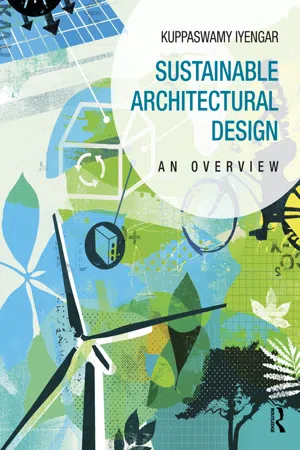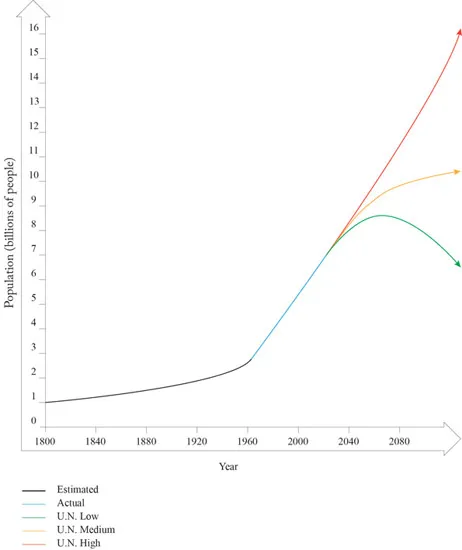Sustainable architectural design is part of an increasing awareness that we must use our ingenuity as creative humans to face the ecological and environmental concerns of our planet. An understanding of the global context informs “green” or ecologically responsive design. This section examines environmental and ecological issues that pertain to architecture and calls for a new social and global sense of responsibility.
Background
Architectural sustainability borrows from the widely accepted global definition, which aims to meet the needs of the present generation without compromising the ability of future generations to meet their own needs [5]. Understanding this broad definition provides a context that can then be narrowed to address architectural issues. Primarily it is important to understand the interaction between natural regenerative systems and the human need for resources. The question that arises here is the magnitude of resources we require to sustain ourselves in this world.
The aim of sustainability is to maintain ecological balance, allowing all life forms the opportunity to survive and flourish. A sustainable society can meet its needs by using the natural resources and ecological services of the planet without degrading the environment that supplies these services. Human demand placed on the environment has the potential to cause imbalance in ecological cycles and impede the production of renewable natural resources for future generations.
Biodiversity becomes crippled when the biosphere cannot keep up its productivity to support human and other life needs and to offset waste. The term “ecological footprint” was conceived at the University of British Columbia by Mathis Wackernagel and William Rees in 1990 to describe our impact on the planet. It is a measurement of how much land, water, and natural resources a person, city, country, or humanity as a whole requires to produce the resources it consumes. To leave no footprint would mean that a person replaces into the environment exactly what he or she takes out of it. Since the mid 1980s, humankind has been in ecological overshoot, meaning we are taking more than we are giving back. For example, according to the Living Planet Report 2006, the ecological footprint of the USA is 9.6 gha (global hectares) per capita × 300 million people = 2,880 gha, while the ecological footprint of India is 0.8 gha per capita × 1,200 million people = 960 gha. Even though the population of the USA is a quarter that of India, its demand for world resources is about three times greater. Other countries fall between these extremes [6]. In other words, we in the USA require far more resources than people in India to sustain our lifestyle, thus leaving a larger impact on the environment. What kind of equity should there be between developed, developing, and underdeveloped countries?
Some might wonder why we should care about sustainability. Prerequisites to healthy and stable societies depend on meeting basic human needs such as controlling unprecedented growth of human numbers and sensible management of vital natural resources (fresh water, forests). Living systems create essential materials such as wood and food. They also provide the services derived from these products (trees can provide building materials, for example). These renewable resources are more critical to human prosperity than nonrenewable resources [1]. Our well-being and our survival depend on our treatment of the planet.
Climatic changes occur as a net result of both internal and external forces. Carbon dioxide is known to absorb long-wave infrared radiation as it rebounds from the Earth’s surface. This CO2 absorption traps the heat in the Earth’s atmosphere, causing a greenhouse effect, without which life on the planet cannot exist. Concentrations of atmospheric GHGs and their associated radiation forces on the Earth’s climatic system have substantially increased as a result of human activities in the last few decades. Atmospheric concentrations of CO2 have climbed from nearly 280 parts per million (ppm) in 1760, when the Industrial Revolution began, to 387 ppm in 2009. In 2008, some 7.9 billion tons of carbon were emitted from the burning of fossil fuels and 1.5 billion tons were emitted from deforestation, for a total of 9.4 billion tons. But since nature absorbs only about five billion tons per year in oceans, soils, and vegetation, nearly half of the remaining emissions stay in the atmosphere, pushing up CO2 levels [2].
Unfortunately, several environmental concerns, including CO2 emissions, water scarcity, population growth, pollution, and more, remain a threat to our planet. Scientists have conclusively declared that uncontrolled CO2 emissions by human activities are the cause of many ecological problems facing the world now and will continue to be a major problem. Climate Change 2007: Synthesis Report, by the Intergovernmental Panel on Climate Change (IPCC), declared that warming of the climate system is unequivocal. As is now evident from observations of increases in global average air and ocean temperatures, most of the global warming in the past 50 years is attributable to human activities. US emissions rose 18 percent in the last decade, while India and China are adding to this global pollution due to their recent tremendous growth. In addition, the updated synthesis document by the Copenhagen Climate Congress [7] concluded that IPCC projections of 2007 are underestimated by 50 percent for mean sea-level rise. A business-as-usual approach to emissions results in global warming that is likely to raise sea levels by several meters in coming centuries, leading to the loss of many major coastal cities and entire island nations, causing severe disruption and consequent damage that can also be expensive.
The latest report, AR4, from the IPCC declares that
unmitigated climate change would, in the long term, be likely to exceed the capacity of natural, managed and human systems to adapt. Many impacts can be reduced, delayed or avoided by mitigation. Mitigation efforts and investments over the next two to three decades will have a large impact on opportunities to achieve lower stabilization levels. Delayed emission reductions significantly constrain the opportunities to achieve lower stabilization levels and increase the risk of more severe climate change impacts.
If the world continues business-as-usual, emissions will double by 2055. To prevent the worst consequences of global warming, scientists recommend freezing and reducing net global emissions at 2010 levels [3].
The difference between the business-as-usual scenario and the flat path of CO2 emissions for the next 50 years can be shown as a triangle (Figure 1.1.1). Pacala and Socolow of Princeton University divided this hypothetical triangle into seven stabilization wedges, which represent different measures that must be taken to reduce emissions. By reducing the stabilization wedge of 14 gigatons of CO2 into seven smaller wedges, the task is much easier to conceptualize. When speaking of different strategies to reduce emissions, the phrase “to reduce one wedge’s worth” is often employed. Essentially, these wedges, each valued at 25 billion tons of carbon, fit broadly into the following four major categories [3]:
- efficiency (four strategies)
- decarbonization of power (five strategies)
- decarbonization of fuel (four strategies)
- forest and agricultural soils (two strategies).
Figure 1.1.1 also shows how important it is to begin managing the climate problem as soon as possible. Of particular interest here is that efficiency is one of the major contributors to reducing GHG emissions. Scientists and designers strongly recommend that actions be taken to reduce emissions of carbon dioxide and other GHGs. Adding scrubbers to power plants and catalytic converters to cars does not significantly limit the carbon dioxide we emit into the atmosphere. Using energy efficiently, however, is a far-reaching strategy that can make an important contribution to the reduction of greenhouse gases.
In addition to the problem of emissions, water scarcity affects one-third of the world at present, and this could dramatically change to two-thirds by 2025. Ten percent of the grain harvest is from pumped water in India, China, and the Great Plains in the USA. Without significant change in water-use practices, this harvest will be unavailable one day.
Figure 1.1.1 Managing climate change.
Current estimates indicate that the world population grew beyond seven billion in 2012. This causes enormous demands on global resources, and meeting those demands causes greater pollution to be emitted to the environment (see Figure 1.1.2).
The Living Planet Report 2006 by WWF International confirms that we are using the planet’s resources faster than they can be renewed. Our ecological footprint has tripled since 1961. Since we have already exceeded our limits to manage our resources, we must act now to bring some balance into our activities on this planet. It is time to make some critical choices to make the impact on the natural world manageable.


